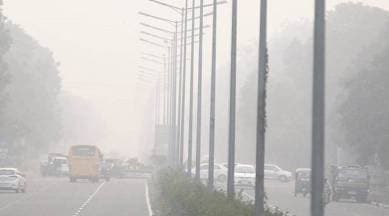Stay updated with the latest - Click here to follow us on Instagram
With AQI of 347, Chandigarh air second worst in country
Stubble burning is mostly behind the bad air quality in the region. However, this year, both the states recorded much less farm fires compared to the previous years.

While the air quality in various cities in Punjab and Haryana has been hovering in the ‘poor’ category, Chandigarh stands out in the region for its alarmingly ‘very poor’ Air Quality Index (AQI) for the past four days.
In fact, on Tuesday at 7.15 pm, Chandigarh recorded an AQI of 347, the second-worst in the country after Hajipur, which hit 437. Cities in Punjab, despite daily paddy stubble burning, reported lower AQI levels. Mandi Gobindgarh recorded an AQI of 268, followed by Ludhiana and Patiala at 223 each, Jalandhar at 210, Amritsar at 209, Ropar at 203, Bathinda at 138. Even Delhi, which is typically a pollution hotspot, recorded an AQI of 317 on Tuesday. In Haryana, the worst AQI of 263 was recorded in Panchkula and Jind. This was followed by 237 in Sonipat, 230 in Bahadurgarh, 228 in Charkhi Dadri, 225 in Bhiwadi, 221 in Panipat, 217 in Kurukshetra and 210 in Gurgaon.
However, Chandigarh is yet to witness a single farm fire this year. Then why is the Union Territory, which has no major industry, not much increase in the existing number of vehicles, is smaller and relatively greener with 45% tree cover, battling extremely poor air quality? An IMD, Chandigarh, offcial points to unfavorable weather conditions, with low wind speeds around 1 km/h, creating a “canopy effect.” Pollutants from vehicular traffic and other sources settle over the city, with little airflow to disperse them. Meteorologists suggest that temperature inversion is also contributing to the pollution trap.
But the experts attribute the reason to discrepancies in Air Quality Index (AQI) calculations.
Chandigarh Pollution Control Committee (CPCC) sources raise concerns about AQI monitoring across Punjab. While Chandigarh has three AQI monitoring stations, most cities in Punjab only have one. CPCC sources said that the placement of AQI in residential, commercial, and traffic-heavy zones is must as per the Central pollution control Board (CPCB) guidelines.
They question if Punjab’s cities might be showing lower AQIs simply because their monitoring stations are way less in number and might be placed in less polluted areas. They also ask if the collected data accurately reflects real conditions, or could it be misleading.
“There is a growing call to reassess the distribution and calibration of AQI monitoring stations across Punjab. If Chandigarh, a small city with fewer sources of pollution, is showing such poor air quality, could other cities be underreporting their AQI levels due to limited monitoring?, said CPCC sources while further arguing that for an accurate picture, AQI monitors should be located strategically in busy commercial zones, residential areas, and traffic hubs, just as Chandigarh has done and which is the thumb rule.
The CPCC highlights that air quality cannot be confined by city boundaries. If Chandigarh’s AQI is critically poor, it’s unlikely that the surrounding areas are unaffected. If the “air canopy” is trapping pollutants over Chandigarh, it could also be affecting nearby areas to a similar degree, said experts.
According to the CPCB on Tuesday, Punjab’ seven cities AQI was recorded and every city has recorded the AQI at just one station instead of the required three.
When contacted, TC Nautiyal, IFS, Member Secretary, Chandigarh Pollution Control Committee (CPCC), said that he stands by the Chandigarh AQI and the location of machines recording it. He said that on November 11, the Task Force under the Graded Response Action Plan (GRAP) convened to address the worsening air quality in Chandigarh. The meeting examined factors contributing to the “very poor” AQI over the past four days, beginning from November 7. Possible causes included stubble burning in Punjab and Haryana, seasonal changes, inversion layers, and festival-related pollution.
“We have already directed the municipal corporation to intensify roadside dust sweeping by sprinkling water and tree washing using water sprinklers and fogging machines. Authorities are also addressing traffic congestion points, believed to be a significant source of pollutants. Restricted manual sweeping, ensuring dust control measures at construction sites, such as green mesh coverings, strict bans on open burning and non-essential generator use and promoting electric vehicles and public transportation options etc.,” said Nautiyal.
PPCB chairman Adarsh Pal Vig when asked about the lower pollution levels in Punjab compared to Chandigarh, he said that the air quality can vary from region to region. Regarding the placement of only one AQI monitoring device per city, he said that these devices measure air quality in just a one-kilometer radius. “The fact remains that air quality is deteriorating day by day due to increasing numbers of vehicles, industrial activities, construction, and more. Instead of focusing on installing additional devices, we should prioritise reducing pollution itself,” he said.
He added that there are no such devices installed in rural areas of Punjab, and also the existing devices provide a general indication of air quality. “We should use this data as a guideline to work towards reducing pollution rather than investing heavily in more monitoring devices,” he said.